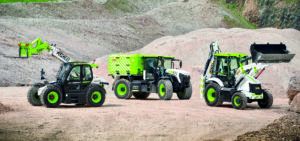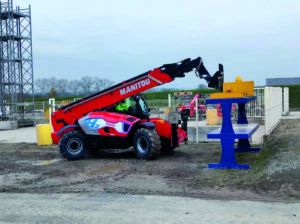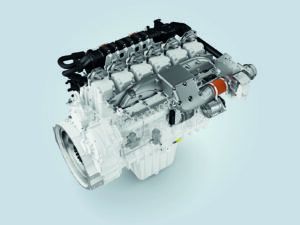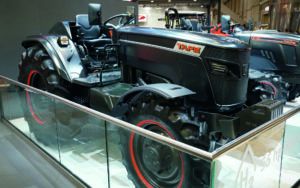A number of OEMs have publicly dedicated to hydrogen combustion engines for future mid-size and heavy tools. However are they market-ready and is the market prepared for them?
Whereas battery know-how and electrification are making market progress as sensible different energy choices for compact development and agriculture automobiles, nearly all of producers would seem satisfied hydrogen-fuelled variations of typical engine bases supply the most effective mix of attributes for heavier machines and better energy calls for. However though current years have seen loads of prototype unveilings at commerce exhibitions and press occasions, full market availability and broad trade adoption of such energy know-how would seem nonetheless a way off.
Whereas the framework has lengthy been in place to produce, retailer and dispense liquid fuels and electrical energy, improvement of the mandatory know-how and infrastructure to do the identical with hydrogen is probably few steps behind that of the machines that may use the gas. It’s this that will seem like what the market must spark demand for hydrogen-fuelled farm and development tools. However is it that easy? What stage are producers at with their machines?
Refuelling improvement

Whereas initially trialling hydrogen gas cell know-how to energy a prototype 360-degree excavator, JCB latterly shifted its hydrogen focus to much less complicated and extra responsive hydrogen-fuelled inside combustion engines, with the added advantages of much less cooling demand and much-reduced weight over a battery-based hydrogen gas cell unit. Nicely-established in its dedication to hydrogen engine energy for its bigger automobiles, having publicly demonstrated backhoe loader and construction-spec telehandler working prototypes, JCB has gone some approach to additionally develop the mandatory know-how to assist hydrogen-engined automobiles.
“Our hydrogen engine improvement just isn’t a conversion, however new combustion know-how,” says Ryan Ballard, engineering director for powertrain at JCB, talking concerning the firm’s four-cylinder engine that options in these working prototypes, and which was given its standalone world debut finally yr’s ConExpo.
“Due to the completely different traits of a gasoline gas in comparison with a liquid one, it requires a totally completely different low-pressure, low-temperature combustion course of. We now have developed a particular oil and additive pack that, at low preliminary engine temperatures, traps the water produced as a combustion by-product. Because the engine warms to working temperature, that water then dissipates.
“We’ve additionally developed a high-efficiency turbocharger that forces far more air into the engine than
an ordinary unit, serving to maximise hydrogen combustion effectivity.”
However whereas the precept of the engine has now been established for a while, the infrastructure required to assist it and others prefer it – and the practicalities of fuelling a machine powered by the unit – are one thing JCB has solely addressed extra not too long ago, with the disclosing of its cellular hydrogen refueller.
Based mostly on the stretched platform of certainly one of its Fastrac 4000-series tractors, the refueller is designed to switch hydrogen gas between on-site bulk storage and hydrogen-powered machines. It options normal nozzle know-how for hydrogen gas supply from refueller to machine, and refuelling time is comparable with that required for refilling with diesel, while the unit’s capability provides it the power to offer as much as 16 refills earlier than the unit itself wants replenishing. The corporate suggests this technique will go well with most customers in that it mirrors how they already handle the refuelling necessities of diesel-powered machines.
Manitou prototypes

Amongst different dealing with tools makers, Manitou Group says that, by 2030, low-emissions merchandise – electrical plus hydrogen – will characterize 43% of its product line. The agency has opened devoted services for hydrogen-powered machine improvement and has a hydrogen-powered prototype telehandler – primarily based on an current 18m-reach development machine – in improvement, with exams ongoing to ensure vary and reliability in real-life situations, plus element sturdiness. Whereas this preliminary prototype makes use of gas cell know-how, Manitou says it’s going to finally choose the hydrogen energy system finest suited to its clients’ wants.
“We’re finding out all of the hydrogen-related applied sciences primarily based on what customers want,” says Michel Denis, president and CEO of Manitou. “This present prototype is simply step one – a second rotating telehandler prototype will probably be developed within the coming months.”
To develop an answer suited to full industrialisation, assist from public authorities to develop an rising ecosystem is vital, emphasises Julien Waechter, Manitou Group vice-president of R&D. “The inexperienced hydrogen sector is steadily changing into extra established with the entry of extra gamers,” he says. “All the support mechanisms proposed by the completely different governments will encourage the transition to hydrogen, and can velocity up the event of the distribution community and finally the discount within the utilization prices of our machines utilizing this vitality. Our intention is to have a 100% hydrogen-powered telehandler available on the market by 2026.”
Whereas JCB has arguably taken a sector lead in hydrogen-engined off-highway car improvement, different multinational OEMs are additionally committing critical R&D cash to hydrogen engine automobiles. Elsewhere within the development sector, Liebherr continues to work on its H964 four-cylinder and H966 six-cylinder engines, the latter having been developed along side the agency’s R 9XX H2 excavator. Collection manufacturing of its hydrogen engines is predicted to start in 2025.
Injection challenges

With increased injection strain and the publicity to combustion pressures and temperatures elevating necessities on injector tightness and sturdiness, Liebherr continues to check its H2 gas injectors and full injection programs for secure and correct direct injection operation. Utilizing a system-oriented method to hydrogen injection, the intention is to match the efficiency of an H2 DI engine to that of a diesel engine, requiring any system to be able to making certain excessive circulate charges.
As a result of low density of hydrogen gasoline, an injector wants giant valve cross-sections. To allow exact management of small portions, the system strain have to be regulated with pinpoint accuracy, factors out Liebherr. Within the agency’s hydrogen injection system, that is achieved through a gasoline quantity management valve, working alongside different pressure- and flow-regulating elements to create a system-oriented method to hydrogen injection. Along with its direct injection actions, Liebherr says it’s working in parallel on consumption manifold injection elements to fulfill completely different engine necessities.
The corporate has been working with Mahle Powertrain to include the latter’s prechamber jet ignition system (MJI), with engine exams displaying that its use can combust the hydrogen/air combine at a excessive compression ratio, maximising the method’s stability and effectivity and enhancing inexperienced hydrogen’s suitability for heavy-duty and off-road functions.
“The problem is to cease engine knocking and untimely ignition with out lowering the compression ratio and thus effectivity and efficiency yield,” says Mike Bunce, head of analysis for Mahle Powertrain US. “To be able to obtain steady operation with a excessive compression ratio while avoiding engine knock and pre-ignition, hydrogen engines have to be operated with a considerable amount of air. The vitality from a traditional spark plug is inadequate to ignite such a mix. Our Jet Ignition solves the issue by burning a small quantity of an ignitable combination in a prechamber. The ensuing gasoline plasma is handed by small openings into the principle combustion chamber and, resulting from its excessive vitality content material, quickly and evenly ignites the principle gasoline combination. Checks with Liebherr’s H966 and H964 engines have delivered glorious outcomes when it comes to combustion velocity, efficiency and emissions.”
Indian push

When it comes to agricultural automobiles, Indian tractor big TAFE used Agritechnica 2023 to mark its broader push into the total western European farm tractor market by unveiling to attendees each battery- and hydrogen-powered developments.
Ravindran Vijayakumar, the corporate’s chief engineer, has revealed that the modified Simpson engine within the tractor produces 55hp/41kW from its three cylinders, however has additionally acknowledged that little additional info will probably be obtainable till additional improvement had been carried out.
“This can be a fully-working prototype, and we all know we are able to carry enough gas for lengthy working durations, with our design engineers having integrated appreciable gas storage functionality into the tractor by purpose-designed tanks behind the operator’s seat and beneath the platform ground,” says Vijayakumar. “That will probably be some of the essential facets of machine acceptance. A tractor with this gas sort can be focused initially at markets with the infrastructure to assist it, which is why we’re making a concerted push into western Europe.”
When it comes to companies targeted solely on manufacturing engines for OEMs, Antonio Leitao, vice-president of off-highway engine enterprise at Cummins, additionally used Agritechnica to underline the corporate’s dedication to hydrogen as a gas for the event of future sustainable drivetrains. By creating options aligned with present car designs, the corporate is ready to minimise complexity for OEMs and end-users, whereas utilizing a foundation of current elements the place potential supplies the maker with economies of scale potentialities and clients with reliability and sturdiness equal to diesel.
“Hydrogen-fuelled inside combustion engines can meet the calls for of probably the most difficult functions, offering the robustness similar to a diesel engine to fulfill agriculture’s excessive working and environmental situations,” says Leitao. “The first distinction is within the machine’s on-board gas storage. By our three way partnership with NPROXX, a specialist in excessive strain hydrogen storage for each stationary and cellular functions, we’re working to assist OEMs with the event of storage tanks offering as much as 700-bar strain functionality to maximise capability.”
Solely ag
With a most energy ranking of 290hp (216kW) and 1,200Nm peak, Cummins says its B6.7H hydrogen engine is aimed squarely on the calls for of agricultural tractors and different machines. Based mostly on a next-generation Stage VI/Tier 5 platform, the engine’s base is unchanged from the six-cylinder block on the agency’s normal B6.7. Cummins calls the engine’s design ‘agnostic’, that means it permits constant mounting/area declare for clear diesel, pure gasoline or hydrogen fuelling infrastructure, and it’s the cylinder head and gas system which can be chief variations.
“We consider hydrogen gas cells can supply an environment friendly energy answer for heavy-duty functions with excessive utilisation and vitality calls for, whereas assembly zero-emission wants, working alongside battery know-how – ultra-capacitors, lithium-ion, or lead-acid – in a parallel hybrid set-up to ship instantaneous response,” says Leitao. “We see hydrogen engines and gas cells as complementary energy sources providing completely different choices to clients relying on the place they’re on their path to zero carbon. Introducing hydrogen engines out there can even speed up the expansion of hydrogen infrastructure to assist the widespread adoption of gas cell powertrains.”
This text first appeared within the June version of iVT Worldwide – https://ivt.mydigitalpublication.co.uk/june-july-2024


